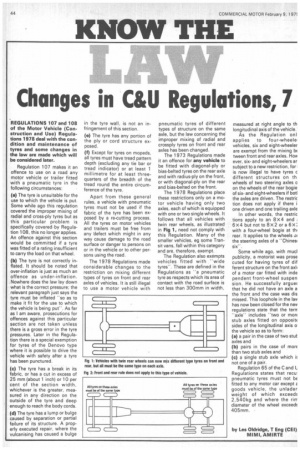Changes in C&U Regulations, 7
Page 46

If you've noticed an error in this article please click here to report it so we can fix it.
REGULATIONS 107 and 108 of the Motor Vehicle (Construction and Use) Regulations 1978 deal with the condition and maintenance of tyres and some changes in the law are made which will be considered later.
Regulation '107 makes it an offence to use on a road any motor vehicle or trailer fitted with a pneumatic tyre in the following circumstances:
(a) The tyre is unsuitable for the use to which the vehicle is put. Some while ago this regulation covered the improper mixing of radial and cross-ply tyres but as this particular problem is specifically covered • by Regulation 108, this no longer applies. An offence against this section would be committed if a tyre was fitted of a rating insufficient to carry the load on that wheel.
(b) The tyre is not correctly inflated. It should be noted that over-inflation is just as much an offence as under-inflation. .Nowhere does the law lay down what is the correct pressure; the relevant paragraph just says the tyre must be inflated "so as to make it fit for the use to which the vehicle is being put". As far as I am aware, prosecutions for offences against this particular section are not taken unless there is a gross error in the tyre pressures. Later in the Regulation there is a special exemption for tyres of the Denovo type where it is possible to drive the vehicle with safety after a tyre has been punctured.
(c) The tyre has a break in its fabric, or has a cut in excess of 25 mm (about 1 inch) or 10 per cent of the section width, whichever is the greater, measured in any direction on the outside of the tyre and deep enough to reach the body cords.
(d) The tyre has a lump or bulge caused by separation or partial failure of its structure. A properly executed repair, where the vulcanising has caused a bulge in the tyre wall, is not an infringement of this section.
(e) The tyre has any portion of the ply or cord structure exposed.
(f) Except for tyres on mopeds. all tyres must have tread pattern depth (excluding any tie bar or tread indicator) or at least 1 millimetre for at least threequarters of the breadth of the tread round the entire circumference of the tyre:
Apart from these general rules, a vehicle with pneumatic tyres must not be used if the fabric of the tyre has been exposed by a re-cutting process. All the tyres on motor vehicles and trailers must be free from any defect which might in any way cause damage to the road surface or danger to persons on or in the vehicle or to other persons using the road.
The 1 978 Regulations made considerable changes to the restriction on mixing different types of tyres on front and rear axles of vehicles. It is still illegal to use a motor vehicle with pneumatic tyres of different types of structure on the same axle, but the law concerning the' improper mixing of radial and crossply tyres on front and rear axles has been changed.
The 1 973 Regulations made it an offence for any vehicle to be fitted with diagonal-ply or bias-belted tyres on the rear axle and with radius-ply on the front, or with diagonal-ply on the rear and bias-belted on the front.
The 1 978 Regulations place these restrictions only on a motor vehicle having only two axles, each of which is equipped with one or two single wheels. It follows that all vehicles with twin rear wheels, as illustrated in Fig 1, need not comply with this Regulation. Many of the smaller vehicles, eg some Transit vans, fall within this category and are, therefore, exempt.
The Regulation also exempts vehicles fitted with "wide tyres". These are defined in the Regulations as "a pneumatic tyre as respects which its area of contact with the road surface is not less than 3 00mm in width, measured at right angle to th longitudinal axis of the vehicle.'
As the Regulation onl applies to four-wheele. vehicles, six and eight-wheeler are exempt from the mixing be tween front and rear axles. Ho ever, sixand eight-wheelers ar subject to a new restriction, for • is now illegal to have tyres c different structures on th wheels of two steering axles a on the wheels of the rear bogie of sixand eight-wheelers if botl the axles are driven. The restric tion does not apply if there i one driven and one trailing axle In other words, the restric lions apply to an 8 x 4 and i 6x4 but not to 8 x 2 or a 6 X : with a four-wheel bogie at thi rear. It applies to the wheels or the steering axles of a ''Chinesi six", Some while ago, with mudl publicity, a motorist was prose cuted for having tyres of dif ferent structure on the front axli of a motor car fitted with inde pendent front-wheel suspen sion. He successfully arguer that he did not have an axle a the front and the case was dis missed. This loophole in the lay has now been closed for the ney regulations state that the terrr "axle" includes "two or more stub axles fitted on opposit( sides of the longitudinal axis o the vehicle so as to form: (a) a pair in the case of two stut axles and (b) pairs in the case of more than two stub axles and (c) a single stub axle which ie not one of a pair.
Regulation 65 of the C and L Regulations states that recu• pneumatic tyres must not bE fitted to any motor car except z goods vehicle, the unlader weight of which exceedE 2,540kg and where the rirr diameter of the wheel exceedE 405rnm. •




































































































